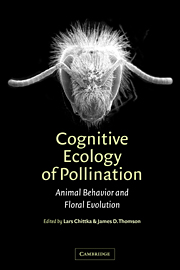Book contents
- Frontmatter
- Contents
- List of contributors
- Preface
- 1 The effect of variation among floral traits on the flower constancy of pollinators
- 2 Behavioral and neural mechanisms of learning and memory as determinants of flower constancy
- 3 Subjective evaluation and choice behavior by nectar-and pollen-collecting bees
- 4 Honeybee vision and floral displays:from detection to close-up recognition
- 5 Floral scent, olfaction, and scent-driven foraging behavior
- 6 Adaptation, constraint, and chance in the evolution of flower color and pollinator color vision
- 7 Foraging and spatial learning in hummingbirds
- 8 Bats as pollinators: foraging energetics and floral adaptations
- 9 Vision and learning in some neglected pollinators: beetles, flies, moths, and butterflies
- 10 Pollinator individuality: when does it matter?
- 11 Effects of predation risk on pollinators and plants
- 12 Pollinator preference, frequency dependence, and floral evolution
- 13 Pollinator-mediated assortative mating: causes and consequences
- 14 Behavioural responses of pollinators to variation in floral display size and their influences on the evolution of floral traits
- 15 The effects of floral design and display on pollinator economics and pollen dispersal
- 16 Pollinator behavior and plant speciation: looking beyond the “ethological isolation” paradigm
- Index
5 - Floral scent, olfaction, and scent-driven foraging behavior
Published online by Cambridge University Press: 13 August 2009
- Frontmatter
- Contents
- List of contributors
- Preface
- 1 The effect of variation among floral traits on the flower constancy of pollinators
- 2 Behavioral and neural mechanisms of learning and memory as determinants of flower constancy
- 3 Subjective evaluation and choice behavior by nectar-and pollen-collecting bees
- 4 Honeybee vision and floral displays:from detection to close-up recognition
- 5 Floral scent, olfaction, and scent-driven foraging behavior
- 6 Adaptation, constraint, and chance in the evolution of flower color and pollinator color vision
- 7 Foraging and spatial learning in hummingbirds
- 8 Bats as pollinators: foraging energetics and floral adaptations
- 9 Vision and learning in some neglected pollinators: beetles, flies, moths, and butterflies
- 10 Pollinator individuality: when does it matter?
- 11 Effects of predation risk on pollinators and plants
- 12 Pollinator preference, frequency dependence, and floral evolution
- 13 Pollinator-mediated assortative mating: causes and consequences
- 14 Behavioural responses of pollinators to variation in floral display size and their influences on the evolution of floral traits
- 15 The effects of floral design and display on pollinator economics and pollen dispersal
- 16 Pollinator behavior and plant speciation: looking beyond the “ethological isolation” paradigm
- Index
Summary
Fragrance is an ancient medium of chemical communication between flowering plants and animal pollinators (Pellmyr & Thien 1986). Pollinators use fragrance for distance orientation, approach, landing, feeding, and associative learning (Williams 1983; Metcalf 1987; Dobson 1994). In turn, scent-driven pollinator preference and constancy has been invoked as an isolating mechanism for diverse angiosperm taxa (Dodson et al. 1969), particularly among sympatric, synchronously blooming species with similar floral form, coloration, and pollination mechanisms (Knudsen 1999). In this chapter, I explore the potential for odor-driven floral evolution by reviewing the physiological and behavioral responses of pollinators to floral scent.
What is fragrance? A floral scent primer
Chemical diversity and biosynthesis
Floral scents are mixtures of small, volatile organic compounds that vary in molecular weight, vapor pressure, polarity, and oxidation state (Knudsen et al. 1993). Diverse chemical classes of floral volatiles are surveyed comprehensively by Croteau & Karp (1991). The analytical methods used to collect and identify floral scent have improved dramatically over the past decade, and are discussed by Raguso & Pellmyr (1998) and Agelopoulos & Pickett (1998). Floral volatiles are produced by biosynthetic pathways, through anabolic and catabolic processes. Figure 5.1 summarizes the major biosynthetic routes to fragrance production, illustrating representative products for each pathway (Azuma et al. 1997). These multifunctional pathways also produce plant pigments, defense compounds, structural components, growth, and signaling substances (Dixon & Paiva 1995). Recent progress in fragrance biosynthesis is reviewed by Dudareva et al. (1999) and Dudareva & Pichersky (2000).
- Type
- Chapter
- Information
- Cognitive Ecology of PollinationAnimal Behaviour and Floral Evolution, pp. 83 - 105Publisher: Cambridge University PressPrint publication year: 2001
- 64
- Cited by



